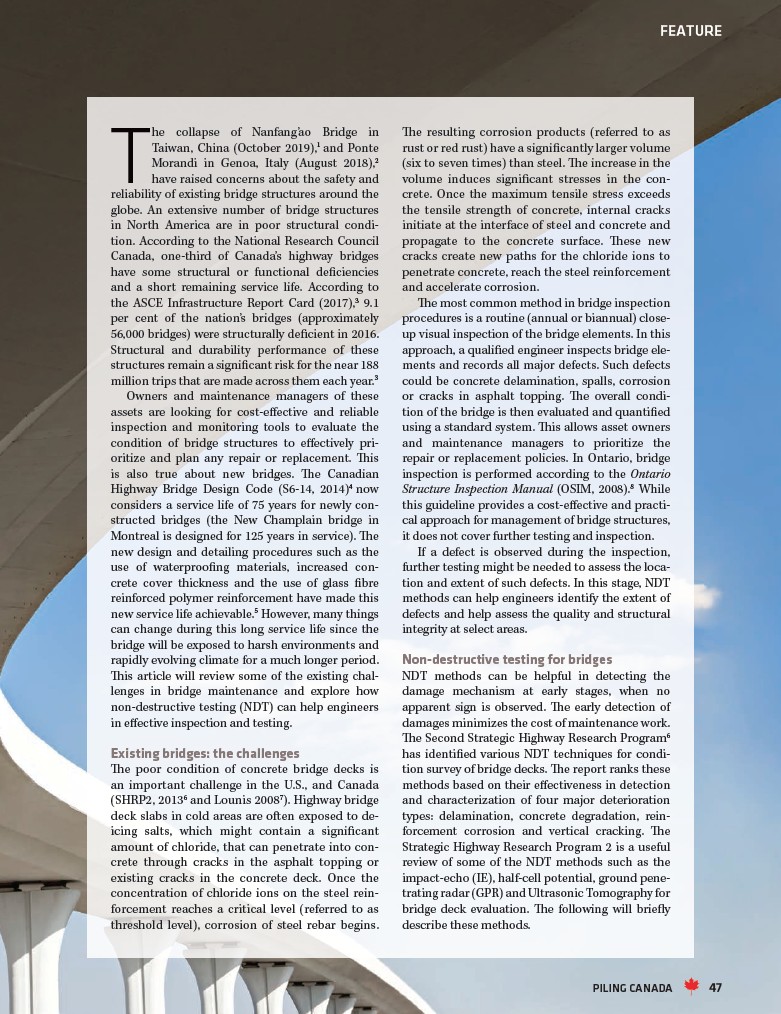
FEATURE
The collapse of Nanfang’ao Bridge in
Taiwan, China (October 2019),1 and Ponte
Morandi in Genoa, Italy (August 2018),2
have raised concerns about the safety and
reliability of existing bridge structures around the
globe. An extensive number of bridge structures
in North America are in poor structural condition.
According to the National Research Council
Canada, one-third of Canada’s highway bridges
have some structural or functional deficiencies
and a short remaining service life. According to
the ASCE Infrastructure Report Card (2017),3 9.1
per cent of the nation’s bridges (approximately
56,000 bridges) were structurally deficient in 2016.
Structural and durability performance of these
structures remain a significant risk for the near 188
million trips that are made across them each year.3
Owners and maintenance managers of these
assets are looking for cost-effective and reliable
inspection and monitoring tools to evaluate the
condition of bridge structures to effectively prioritize
and plan any repair or replacement. This
is also true about new bridges. The Canadian
Highway Bridge Design Code (S6-14, 2014)4 now
considers a service life of 75 years for newly constructed
bridges (the New Champlain bridge in
Montreal is designed for 125 years in service). The
new design and detailing procedures such as the
use of waterproofing materials, increased concrete
cover thickness and the use of glass fibre
reinforced polymer reinforcement have made this
new service life achievable.5 However, many things
can change during this long service life since the
bridge will be exposed to harsh environments and
rapidly evolving climate for a much longer period.
This article will review some of the existing challenges
in bridge maintenance and explore how
non-destructive testing (NDT) can help engineers
in effective inspection and testing.
Existing bridges: the challenges
The poor condition of concrete bridge decks is
an important challenge in the U.S., and Canada
(SHRP2, 20136 and Lounis 20087). Highway bridge
deck slabs in cold areas are often exposed to deicing
salts, which might contain a significant
amount of chloride, that can penetrate into concrete
through cracks in the asphalt topping or
existing cracks in the concrete deck. Once the
concentration of chloride ions on the steel reinforcement
reaches a critical level (referred to as
threshold level), corrosion of steel rebar begins.
The resulting corrosion products (referred to as
rust or red rust) have a significantly larger volume
(six to seven times) than steel. The increase in the
volume induces significant stresses in the concrete.
Once the maximum tensile stress exceeds
the tensile strength of concrete, internal cracks
initiate at the interface of steel and concrete and
propagate to the concrete surface. These new
cracks create new paths for the chloride ions to
penetrate concrete, reach the steel reinforcement
and accelerate corrosion.
The most common method in bridge inspection
procedures is a routine (annual or biannual) closeup
visual inspection of the bridge elements. In this
approach, a qualified engineer inspects bridge elements
and records all major defects. Such defects
could be concrete delamination, spalls, corrosion
or cracks in asphalt topping. The overall condition
of the bridge is then evaluated and quantified
using a standard system. This allows asset owners
and maintenance managers to prioritize the
repair or replacement policies. In Ontario, bridge
inspection is performed according to the Ontario
Structure Inspection Manual (OSIM, 2008).8 While
this guideline provides a cost-effective and practical
approach for management of bridge structures,
it does not cover further testing and inspection.
If a defect is observed during the inspection,
further testing might be needed to assess the location
and extent of such defects. In this stage, NDT
methods can help engineers identify the extent of
defects and help assess the quality and structural
integrity at select areas.
Non-destructive testing for bridges
NDT methods can be helpful in detecting the
damage mechanism at early stages, when no
apparent sign is observed. The early detection of
damages minimizes the cost of maintenance work.
The Second Strategic Highway Research Program6
has identified various NDT techniques for condition
survey of bridge decks. The report ranks these
methods based on their effectiveness in detection
and characterization of four major deterioration
types: delamination, concrete degradation, reinforcement
corrosion and vertical cracking. The
Strategic Highway Research Program 2 is a useful
review of some of the NDT methods such as the
impact-echo (IE), half-cell potential, ground penetrating
radar (GPR) and Ultrasonic Tomography for
bridge deck evaluation. The following will briefly
describe these methods.
PILING CANADA 47